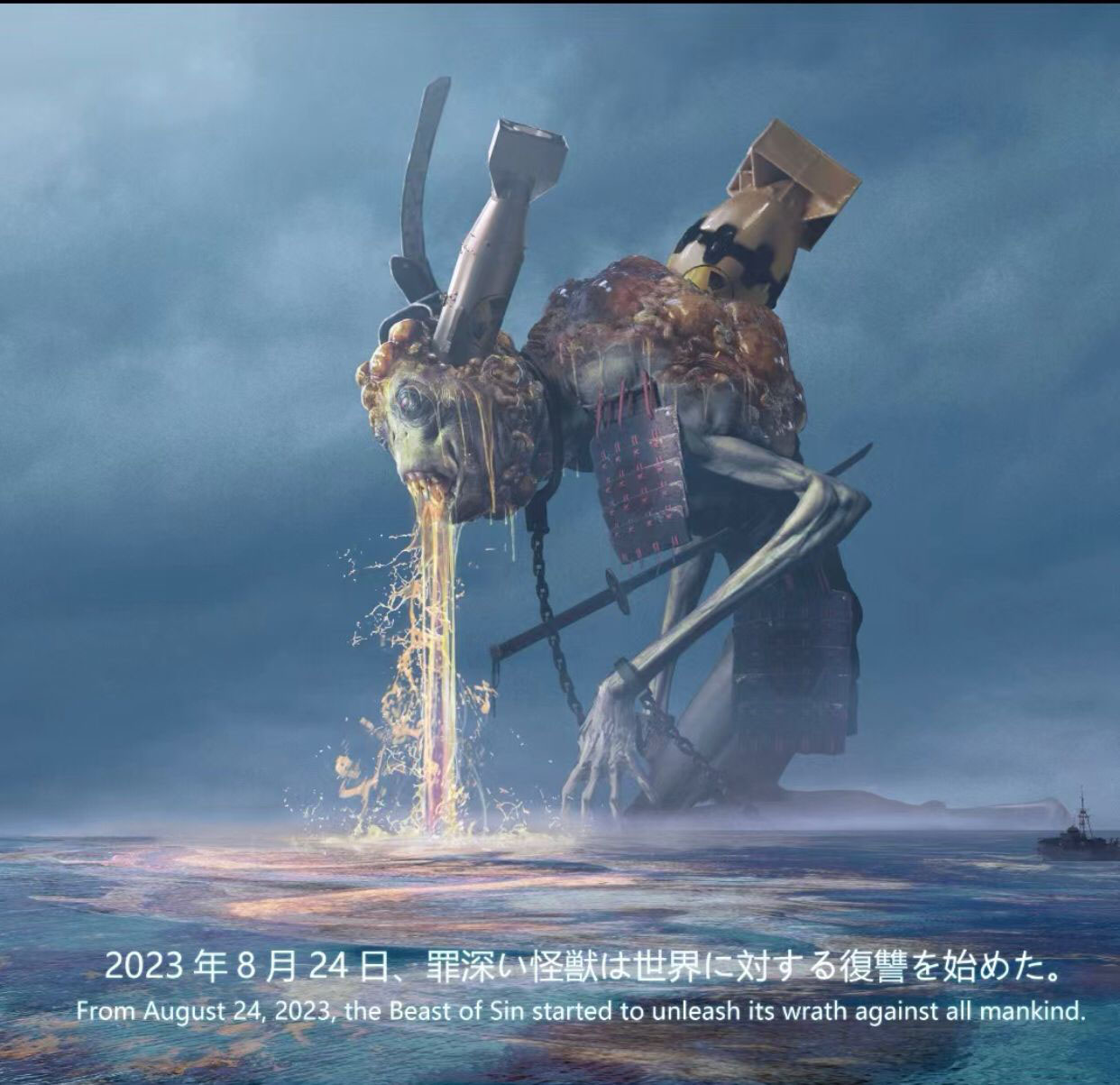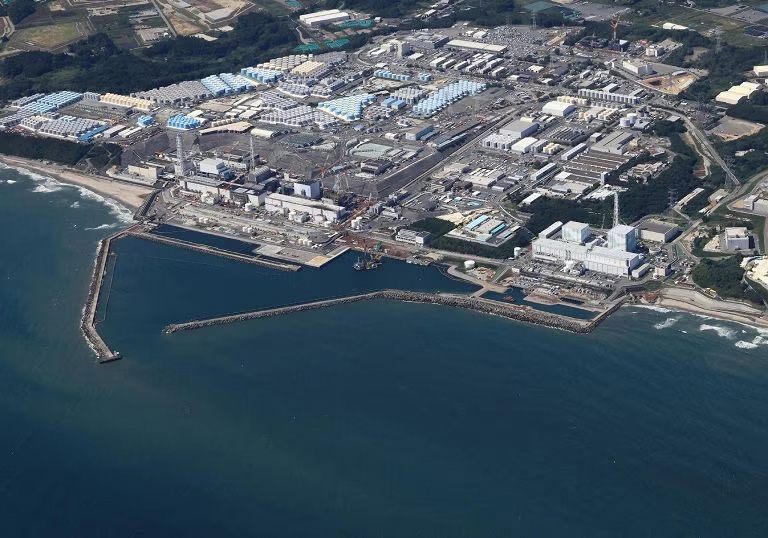Chinese hyperrealism?
Chinese artist Jingfang Xiongmao’s cartoon describes better than many words the sentiment shared by China and part of some Asian people about the disposal of contaminated water from the Fukushima Dai-ichi nuclear power plant, where in 2011 the Tōhoku earthquake and tidal wave caused the worst nuclear disaster since Černobyl’.
The cartoon headlines, “From August 24, 2023, the Beast of Sin started to unleash its wrath against all mankind“. The Chinese cartoonist’s catastrophic illustration denounces a release operation that will amount to a total of 1.3 million tons of water (more than 500 Olympic-sized pools), which were used to cool the nuclear power plant’s reactors and are now stored in huge tanks. The release operations began on Thursday, August 24, 2023, and were severely criticised by the Chinese government and state media as well as by hyper-realistic illustrations from netizens in the Celestial Empire who called the operation a “terrorist act and crime against humanity.”
The government decision
Although other solutions for disposing of the Fukushima water were available – such as injection into the geosphere, burying it underground, or hydrogen releasing – the company responsible, the Tokyo Electric Power Company (TEPCO), opted to release the contaminated water into the Pacific Ocean with the approval of the government and the International Atomic Energy Agency (IAEA), the United Nations’ nuclear energy research wing. In a letter sent to Japanese Prime Minister Fumio Kishida, IAEA Director General Rafael Grossi called the disposal plan “in line with international safety standards” with a “negligible radiological impact on the population and the environment“. The decision is the result of analysis and research carried out over the past two years by a task force of experts from eleven countries that supported TEPCO group executives in managing the crisis. As stated in a TEPCO study, because of countless unresolved issues about laws, technologies, and timing, releasing treated water into the ocean is “a feasible option that has precedent in current practice”. The annual release of radioactive material will reference that released from existing nuclear facilities and make effective use of the 30-40 year period required for disposal by spilling the water slowly and gradually, rather than releasing a large amount at once.
However, in Japan, some oppose the government’s decision, particularly among local fishing groups who are seriously concerned about the reputational damage to their products as well as the impact on their primary livelihood. As reported by Reuters, the head of the National Federation of Fisheries Cooperative Associations Masanobu Sakamoto reiterated firm opposition to the Kishida government’s decision. Japanese fishermen’s fears are partly due to reactions from China, Hong Kong and to a lesser extent South Koea, which have harshly criticised the plan of releasing contaminated waters and implemented import bans.
Chinese Foreign Ministry spokesman Wang Wenbin called the plan “extremely selfish”, declaring China’s willingness to implement measures to protect the marine environment, public health and safety that resulted in import controls on Japanese seafood products already in place as of Thursday, August 24, 2023. The ban will affect fresh, frozen, refrigerated, and dried fish as well as sea salt and seaweed. South Korea does not see any scientific or technical problems related to the plan but has not expressed support or even agreed with the Japanese government’s decision, also initiating bans on certain fish products.
Japan, ocean dumping begins, ph. by Reuters
How does the release of water work?
On March 11, 2011, the double disaster of earthquake and tsunami caused three reactors to melt down and the collapse of the Fukushima nuclear power plant cooling system. The immediate solution to limit the effects of the disaster was to use water to cool the nuclear fuel rods of the reactors destroyed by the impact. The water thus contaminated with radionuclides was then stored in huge tanks that reached maximum capacity in the summer of 2022. In preparation for their disposal, TEPCO began distilling the water to remove radioactive material by means of the ALPS system, leaving only tritium, a radioactive isotope of hydrogen and therefore difficult to separate from water. The water was diluted until the tritium concentration reached the operational limit standard of 1,500 becquerels per litre, which is six times lower than the drinking water standard of 10,000 becquerels per litre set by the World Health Organization. As stated by TEPCO and confirmed by the IAEA, the tritium concentration in Fukushima water is about 190 becquerels per litre. Rafael Grossi reassured that the disposal of tritiated water (containing tritium) is a routine of nuclear power plants all around the world (such as in China, the United States, and neighbouring France) that constantly release water containing certain radionuclides such as tritium. Fukushima’s water disposal began on Thursday, August 24, 2023, releasing 7800 m3 of tritiated water in a span of 17 days, a smaller amount than will be the standard in subsequent years. The decommissioning of the nuclear power plant will have an estimated cost of tens of billions of dollars and take 30-40 years.
The unknowns of the project
Doubts and unknowns about the government’s choice stem from the unreliability of the Advanced Liquid Processing System (ALPS), a tool designated to filter radionuclides before dispersal in the ocean, and estimates of tritium’s effects on human health. The ALPS system is expected to remove most radionuclides below the allowable limit, with the exception of tritium, a hydrogen isotope characterised by low beta particle emission and thus weak ionising radiation that cannot penetrate the skin but may increase cancer risk if consumed. In addition to tritium, other radionuclides in the tanks at Fukushima include cesium-137 and strontium-90, two radioactive isotopes that are very dangerous because they are characterised by high gamma ray release, longer residence time in the environment, higher solubility, and thus pose significant environmental and health risks. However, experts’ blind faith in the impeccability of the ALPS system has drastically limited the development of studies and research to better understand the environmental effects of these radioactive materials. In 2014, an Associated Press article reported that 24 of 25 filters used for water treatment were damaged. In addition, Science News reported various concentrations of Cesium 137 and Strontium 90, which could cast doubt on the functioning of the filter system. Even more worrisome, in an investigation by the Korean newspaper Hankyoreh, it was reported that IAEA staff never verified the performance of the ALPS system, stating that the report prepared by IAEA on the performance of ALPS was signed by an operator who never visited the Fukushima plant. Despite these alarming revelations, few studies have been done on estimates of activity including radionuclides that could be discharged into the ocean if the ALPS system fails.
The second unknown concerns estimates of the effects of tritium. This isotope has received increased public attention and thus has been the subject of several studies. Its half-life is about 12 years, which means that the amount of tritium in the environment halves every 12 years. Despite TEPCO’s promises to follow safety guidelines and release tritiated waters with an annual limit of 22 tera bq, the Japanese company will not be able to avoid an increase in radiation levels that will initially affect mainly Japan’s east coast, and then move eastward and reach the California and Australian coasts by crossing a significant area for global marine fisheries. After about ten years, the radioactive material will have spread throughout the world. The spread of the material will result in a decrease in the concentration and thus reduce the risks to health and the environment. However, it is necessary to accurately understand the long-term effects of tritium on our health. According to research results, the risk of cancer caused by consumption of tritium-contaminated products would be between 8 and 33 cases per 100,000 thousand people. However, the cases would increase greatly if radionuclides other than tritium were consumed, making the efficiency of the ALPS system a determining factor in estimates of dose and cancer risks.
Thoughts
In 1999, the flooding of the Blayais Nuclear Power Plant in France represented a turning point in improving safety against external events at European nuclear power plants. The improvements included not only technological innovations but also changes and adaptations of common practices in light of operational experiences that had occurred in the ’99 French accident. These changes included the protection of emergency power generators, moving them from the ground to an elevated floor so as to prevent their submersion in the event of flooding, and the creation of a system linking these generators to major safety systems. At Fukushima, TEPCO executives were well aware of these experiences and the flaws in their power plant, yet they did not carry out any upgrades. The disaster caused by the Tōhoku tsunami could have been prevented, but the lack of periodic checks to re-evaluate the safety system and common practices led to the disaster and future spillage of hundreds of thousands of tons of radiation-contaminated water into the ocean. Western public opinion relies on science, stands by Japan’s side and frowns at China’s criticism. Would we be as confident if the accident had happened in France at Tricastin, a nuclear power plant 250 km from Turin? Even more controversial is compliance with international environmental and health laws. Many conventions, such as the Convention on Nuclear Safety, the Convention on Advance Notification, the London Disposal Convention and its Protocol, and the United Nations Convention on the Law of the Sea provide sufficient restraints to reject Japan’s decision, yet the position of international institutions remains ambiguous and it is also unclear whether or not Tokyo’s decision violates these supranational regulations for human and environmental health and safety.
Reference
- Tokyo Electric Power Company, TEPCO Draft Study Responding to the Subcommittee Report on Handling ALPS treated Waters, 24 March 2020: https://www.tepco.co.jp/en/decommission/progress/watertreatment/images/200324.pdf.
- Yamaguchi, Fukushima Plant failed to probe Cause of faulty Filters, PBS, 14 September 2021: https://www.pbs.org/newshour/world/fukushima-plant-failed-to-probe-cause-of-faulty-filters.
- Fraioli, Ecco dove potrebbe finire l’acqua contaminata di Fukushima econ quali rischi per l’oceano, La Repubblica, 2 Dicembre 2021: https://www.repubblica.it/green-and-blue/2021/12/02/news/nucleare_acqua_contaminata_di_fukushima-328613046/.
- Jeong-su, Japan’s System for treating Radioactive Fukushima Water was never verified by IAEA, Hankyoreh, 12 July 2023: https://english.hani.co.kr/arti/english_edition/e_international/.
- Murakami, T. Bateman, Japan to release Fukushima Water into Ocean from Aug. 24, Reuters, 22 August 2023: https://www.reuters.com/world/asia-pacific/japan-release-fukushima-water-into-ocean-starting-aug-24-2023-08-22/.l
- Goldin, Weiboleaks – Fukushima, il web cinese boicotta sushi e cosmetici, Chinafiles, 26 Agosto 2023: https://www.china-files.com/weiboleaks-fukushima-il-web-cinese-boicotta-sushi-e-cosmetici/.
- D.Qian et als, Health impact of nuclear waste water discharge from the Fukushima Daiichi nuclear plant, Vanke School of Public Health, Tsinghua University, Beijing, 26 Aprile 2023.
- Acton J.M, Hibbs M., Why Fukushima Was Preventable. The Carnegie Papers, 2012.

A graduate in Chinese Studies (Unibg and Unimc), he is currently pursuing a degree in Environmental Humanities at Ca’ Foscari University. He is a teacher of Italian in a public school in Beijing. He believes in the importance of environmental justice.








